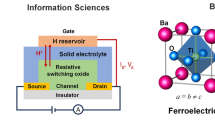Abstract
Diamond is the only wide band gap representative of the elemental semiconductors, with a crystal structure identical to its more common relatives silicon and germanium. On first glance one might also expect similar surface properties in terms of reconstructions, surface states, and surface band diagrams. In part, this expectation is indeed fulfilled, but diamond also exhibits a number of unusual and potentially very useful surface properties. Particularly when the surface dangling bonds are saturated by monovalent hydrogen atoms, (donor-like) surface states are removed from the gap, the electron affinity changes sign and becomes negative, and the material becomes susceptible to an unusual type of transfer doping where holes are injected by acceptors located at the surface instead of inside the host lattice. These surface acceptors can in the simplest case be adsorbed molecules conveniently chosen by their electron affinity, but they can also be solvated ions within atmospheric water layers or electrolytes in contact with the hydrogenated diamond surface. The understanding of those phenomena requires in fact concepts of surface science, semiconductor physics, and electrochemistry, which makes the diamond surface a true ‘interdisciplinary’ research topic.
Similar content being viewed by others
References
Nebel CE, Ristein J (eds) Thin-Film Diamond I and II (Semicond Semimet 76–77) (Elsevier/Academic, New York, 2003–2004)
Isberg J, Hammersberg J, Johansson E, Mikström T, Twitchen DJ, Whitehead AJ, Coe SE, Scarsbrook GA (2002) Science 297:1670
Kaiser W, Bond WL (1959) Phys Rev 115:857
Jiang X et al (1993) Appl Phys Lett 62:3438
Stoner BR, Glass JT (1992) Appl Phys Lett 60:698
Schreck M, Roll H, Stritzker B (1999) Appl Phys Lett 74:650
Kern G, Hafner J, Furthmüller J, Kresse G (1996) Surf Sci 352–354:745
Graupner R et al (1997) Phys Rev B 55:10841
Graupner R et al (1999) Phys Rev B 60:18023
Frauenheim T et al (1993) Phys Rev B 48:18189
Jing Z, Whitten JL (1994) Surf Sci 314:300
Zheng JC et al (2001) Diamond Relat Mater 10:500
Wang YM et al (2000) Diamond Relat Mater 9:1582
Zheng XM, Smith PV (1992) Surf Sci 262:219
Pandey KC (1981) Phys Rev Lett 47:1913
Kern G et al (1996) Surf Sci 366:445; note that Figs. 5 and 7 in this publication have been erroneously exchanged
M. Marsili, O. Pulci, F. Bechstedt, R. del Sole, Phys. Rev. B, in press
Loh KP et al (2002) Diamond Relat Mater 11:1379
Hanney NB, Smith CP (1946) J Am Chem Soc 68:171
Topping J (1927) Proc R Soc London 114:67
Maier F, Ristein J, Ley L (2001) Phys Rev B 64:165411/1-7; note that the units of the dipole moment and the exponent of the polarizability of the C-H bonds were mistyped in this publication
Cui JB, Ristein J, Ley L (1998) Phys Rev Lett 81:429
Cui JB, Ristein J, Ley L (1999) Phys Rev B 59:5847
Landstrass IM, Ravi KV (1989) Appl Phys Lett 55:975 and 1391
Maier F et al (2000) Phys Rev Lett 85:3472
Ristein J et al (2002) Diamond Relat Mater 11:359
Takeuchi D et al (2003) Phys Rev B 68:041304(R)
Riedel M et al (2004) Diamond Relat Mater 13:746
Riedel M et al (2004) Phys Rev B 69:125338
Goss JP et al (2001) J Phys Condens Matter 13:8973
Strobel P, Riedel M, Ristein J, Ley L (2004) Nature 430:439
Strobel P, Riedel M, Ristein J, Ley L (2005) Diam Relat Mater 14:451
Kawarada H (1996) Surf Sci Rep 26:205
Maier F, Graupner R, Hollering M, Hammer L, Ristein J, Ley L (1999) Surf. Sci. 443:177
Kern G, Hafner J (1997) Phys. Rev. B 56:4203
Author information
Authors and Affiliations
Corresponding author
Additional information
PACS
68.35.-p; 73.20.-r; 73.25.+i
Rights and permissions
About this article
Cite this article
Ristein, J. Diamond surfaces: familiar and amazing. Appl. Phys. A 82, 377–384 (2006). https://doi.org/10.1007/s00339-005-3363-5
Received:
Accepted:
Published:
Issue Date:
DOI: https://doi.org/10.1007/s00339-005-3363-5




